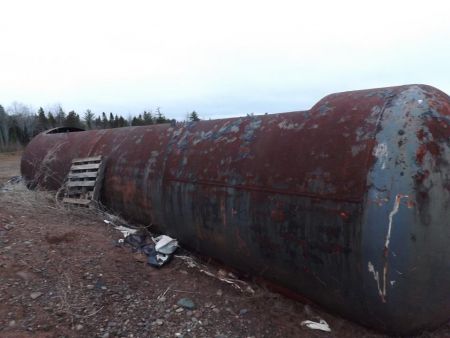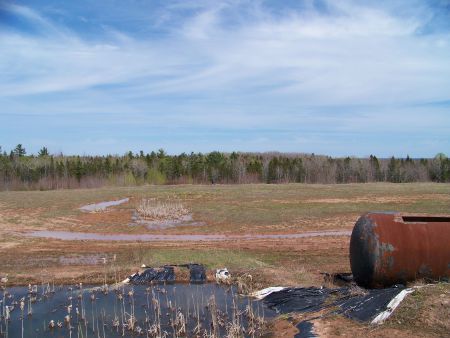Last night, over 70 people attended a community meeting on fracking in Centre Burlington, Hants County. The meeting itself was spearheaded by Kimm Kent. Attendees included members of Glooscap First Nation.
Guest speaker was Jennifer West of the Ecology Action Centre and Coordinator of NOFRAC, who Kent had recently met at a Federation of Agriculture meeting.
The tipping point that got Kent, a Cogmagun, Hants County resident to organize the community meeting was the surprising information that there was an 11 year old abandoned oil well site in her own community. She asked neighbours where it was, and her family hiked along a back woods road to find it.
When they found it, Kimm's first question was: “Who is responsible for this?”
The Cogmagun # 1 oil well site is off a well traveled woods road in Cogmagun, Hants County. The 100 metre by 100 metre wellpad is on moderately sloped terrain. The wellpad itself has to be level, and this was achieved by excavating all the soil and subsoil from the western high end, and depositing it on the lower end.
Most of the surrounding area had been clear-cut not long before the 2003 drilling of the oil well. Natural regeneration has developed healthy sized young trees all around the wellpad. But due to the compacting by all the heavy equipment in building the wellpad, and the irregularity of the churned up soil material, nothing is growing on the site.
The excavation and leveling of the wellpad was a substantial undertaking. So would be its restoration to the previously existing state that is explicitly required in the drilling permits granted by the province's Department of Energy.
Eleven years after the abandonment of the well, that has not been done; and, not surprisingly, there is heavy erosion of the filled soil material.
The only required activity that has been completed is the removal of the wellhead when the well was abandoned. Hopefully, that was capped as required before it was buried. That remains to be determined, and is not always done properly in a loosely regulated environment where there is little or no oversight by regulators.
The site hosts a very large do-it-yourself holding tank cut out of a piece of scrapped industrial equipment. Next to it is a tailing pond lined with black plastic. The long decayed liner with cattails growing through it is of the thickness used by gardeners, rather than of the far heavier grades used, for example, in fracking waste ponds.
The metal holding tank was presumably for mixing drilling muds, and the tailing pond was for discharging the used muds returned up the well during drilling. Drilling muds and the waste water returned tend to be more toxic than fracking waste water, because of the concentrations of the chemicals used. The disposal of both of them is regulated. But what actually happened with those Cogmagun # 1 wastes, and the regulatory oversight of that, is another question that the Department of Energy will have to address.
The tank and the tailing pond with the decrepit liner that has cattails growing through it are both full of rainwater. But even 11 years later, the sludge at the bottom may still have significant concentrations of hazardous substances used in the drilling, and of the naturally occurring toxins brought back up with the material from the drilled well bore.
All of these issues are supposed to be taken care of in the required abandonment and site reclamation.
Who is responsible for this?
The 2003 drilling was done by Oiltec Resources of Calgary. The land is part of the large Windsor Block Exploration Lease that includes the later wells drilled and fracked in Kennetcook and Noel. That lease was held at the time by Contact Exploration, who are now active in New Brunswick.
Oiltec's drilling agreement was what is called a 'farm-in' to Contact's exclusive right to explore the Windsor Block. And typical of such arrangements, Contact also chipped in 10% of drilling and reclamation costs for 10% ownership of any resource found and developed.
When Oiltec decided it did not want to drill another exploratory well, it traded it's 90% ownership of a share of any prospective future successful efforts by other companies to Contact, in return for Contact assuming sole responsibility for site reclamation.
So Contact got the benefits and for six years did nothing about site reclamation, apparently without any oversight from the regulator. The company president at the time was Darcy Spady, now Vice President of St. Brendan's Exploration that holds Nova Scotia's newest exploration leases along the North Shore.
Darcy Spady has given numerous interviews and public presentations where he lauds his company and the industry as good corporate citizens.
Triangle Petroleum took over as the active operator of the Windsor Block lease in 2007, because of the opportunity they saw in shale gas development. Contact Exploration retained a minority interest in ownership of that lease.
In 2009 Triangle bought out Contact's remaining ownership interest in the Windsor Block lease. One of the few itemized details in their legal agreement has Darcy Spady and Contact Exploration making sure that Triangle was assuming legal responsibility for reclamation of the Cogmagun oil well site.
At that time, investors behind Triangle Petroleum had recruited experienced oil industry executive Peter Hill to be on that company's Board and to lead the turn-around of the by then financially troubled company. Peter Hill has been the very public and accessible Chief Executive of Triangle while it has been navigating the contentious issues of cleaning up its Kennetcook sites of the wells fracked in 2008.
Peter Hill did not sign the agreement with Contact and did not then have executive authority with Triangle. But that agreement with Contact was an essential piece of consolidating Triangle's position that it's investors had tasked him with.
Triangle Petroleum drilled five wells into the shale bed in 2007 and 2008. All wellpad sites that are not further developed are required to be fully reclaimed before the permits for operating on the sites expire. All five of Triangle's original permits have expired. None have had any reclamation.
Reclaiming two of those wellpads has been complicated by lack of agreement over how to dispose of the wastes in the holding ponds on them. But the other three wellpads do not have holding ponds, and no reclamation has been done there either. Neither the company nor the regulator- Department of Environment in this case- has ever publicly given a reason for the lack of reclamation.
Because of public scrutiny that began in 2011, the situation of those five Triangle wells has at least been more or less out in the open, even if not explicitly acknowledged. But the Cogmagun well site has been sleeping out of sight while Triangle has had sole legal responsibility for the last five years.
Where has the regulator been all this time ?
To Kimm Kent's basic “Who is responsible for this?” question, the answer appears to be clear. Triangle Petroleum, already of fracking fame in Nova Scotia, seems to have sole legal responsibility for the Cogmagun #1 reclamation that has not been done.
But where has the regulator been for 11 years? There are about two onshore oil or gas wells drilled per year for them to supervise. There appears to be a lot of Departmental staff time for promoting oil and gas development, and for facilitating companies getting their permits to drill.
Kimm Kent has submitted a Freedom of Information request for documentation about the Cogmagun # 1 well. It remains to be seen whether there is any documentation to establish whether the Department of Energy has been aware of the situation at the Cogmagun well site, and whether the regulator had taken any steps to ensure that Oiltec Resources, Contact Exploration, or Triangle Petroleum met requirements to reclaim the oil well site.




